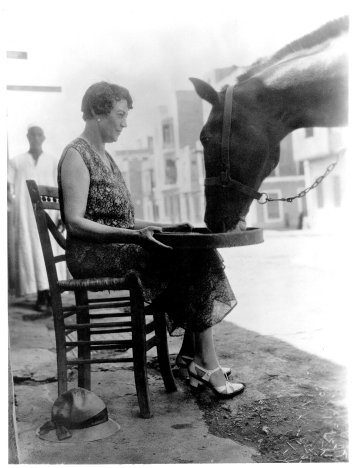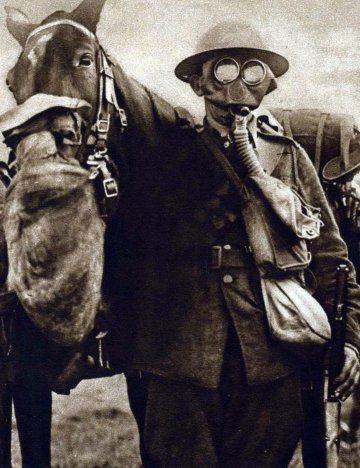Honouring animals in war
Each November Brooke takes time to honour and reflect on the heroic struggle of working horses, donkeys and mules of the past and present, and help build better lives for future generations.
In 1930 our founder, Dorothy Brooke, discovered thousands of former British war horses left suffering in Egypt - abandoned and too costly to send home.
The sight of these horses shook Dorothy to her core, prompting her to establish the Old War Horse Memorial Hospital to ensure they were treated with care, respect and compassion.
Today, Dorothy’s work is known by another name: Brooke, dedicated to improving the lives of working horses, donkeys and mules and those that depend on them.

To mark Brooke's annual Every Horse Remembered campaign, we’re exploring the vital role of working animals both in wartime and present day, around the word.
World War 1
A staggering 8 million horses served in WW1, depended upon as a reliable and accessible form of transport when motorised vehicles were not yet widely used.
Carrying essential supplies to the frontline such as food, guns and ammunition, horses could navigate routes that soldiers struggled to on foot.
In instances where roads had been destroyed or terrain was too rough, the size and strength of horses allowed them to carry goods on their back - a crucial solution when wagons or vehicles could go no further.
Each November, Brooke reflects on the heroic bravery of working horses, donkeys and mules in the past and present, to honour these animals and give them a life worth living for generations to come.
In 1930 our founder, Dorothy Brooke, discovered thousands of former British war horses now suffering in Egypt - abandoned and too costly to send home.
The sight of these horses shook Dorothy to her core, prompting her to establish the Old War Horse Memorial Hospital to ensure they were treated with care, respect and compassion.
Today, Dorothy’s work is known by another name: Brooke, dedicated to improving the lives of working horses, donkeys and mules and those that depend on them.

Horses were also used to pull ambulance wagons in WW1, providing life-saving treatment and medicine for soldiers fighting on the frontline.
Horse-drawn ambulances ensured that casualties could make it to hospital quickly and receive the treatment they needed.
Despite their courageous actions, WW1 also led to a tragic loss of life for horses, with 484,000 killed serving under the British Army - one horse for every two men.
'Bess the Brave'
Only four of 100,000 horses from New Zealand returned home from WW1, and one pictured here was a thoroughbred mare named Bess.
Dark brown with a small white star on her head, Bess was allocated to the Wellington Mounted Rifles Regiment and selected by Captain C.G. Powles.
Together, they served throughout the war in Egypt, Sinai, Palestine and France.
Powles described Bess as an “ideal charger, a sound hunter, and could see at night like a cat.” During one battle, a shell exploded in front of Bess, throwing Powles to the ground who she stayed with until help arrived.
When the enemy retreated, they rode through an ancient Israeli town where villagers greeted them, and Powles lifted a little girl onto Bess’s back so they could ride through the streets together.
Today, Bess has been acknowledged by the New Zealand Racing Hall of Fame, and even has two children’s books dedicated to her legacy.
World War 2
An estimated 3-6 million horses were used in WW2 (far fewer than WW1 thanks to advances in mechanisation), but the role they played was just as significant.
It was even recorded that nearly 80% of German efforts were horse-powered during the war - the most wide-scale use of horses for any wartime effort throughout history.
Much like WW1, horses were used as vital forms of transportation for soldiers and resources.
This was mainly over remote or harsh terrain, as motorised vehicles became the preferred method of travel.
As tanks also began to take over, cavalry horses supported instead with infantry, tank units and security patrols.
German forces heavily relied on horse-drawn supply transport, as unlike their enemies they could not access fuel easily and keep up with vehicle and tank production.
During both World Wars, men on the frontlines developed strong bonds with their horses, and equine casualties hit them extremely hard.
It is estimated that 3.5 million equines were killed during WW2 - 3.25 million of these from German and Russian calvaries alone
Comrades and companions
Many military units in the U.S. adopted animal mascots, considered to bring them good luck and provide morale as pets for the men of a squad, company or ship.
Individual soldiers also adopted animals, often local ones left homeless by war. For these animals, being in a soldier’s care meant survival, who in turn brought companionship and comfort amongst the brutality of battlefield.
What about today?
Today, we can draw a number of parallels to the past about the contributions of working horses, donkeys and mules. Here are just a few:
Transporting goods - from fetching clean water to agricultural production, working horses and donkeys ensure entire communities stay food and water secure.
Much like their wartime ancestors, they are relied upon heavily to move resources and goods and access terrain inaccessible by foot.
Saving lives - like the ambulance wagons during war, horses and donkeys provide pivotal emergency relief during disasters by relocating families and supplying food, water and medicine to those in need.
This helps to build community resilience, necessary for soldiers and families alike. Working horses and donkeys also provide critical economic support through their work in industries like brick kilns and coal mines, helping lift families out of poverty.
Mutual trust - horses, donkeys and mules are intelligent animals who work alongside their owners in some of the most challenging environments.
Whether on a battlefield, brick kiln, or supporting families to send their children to school, these animals support social and economic mobility through strong, unique bonds with the people around them.
Learn more about the valiant role working horses and donkeys played during the World Wars here.
